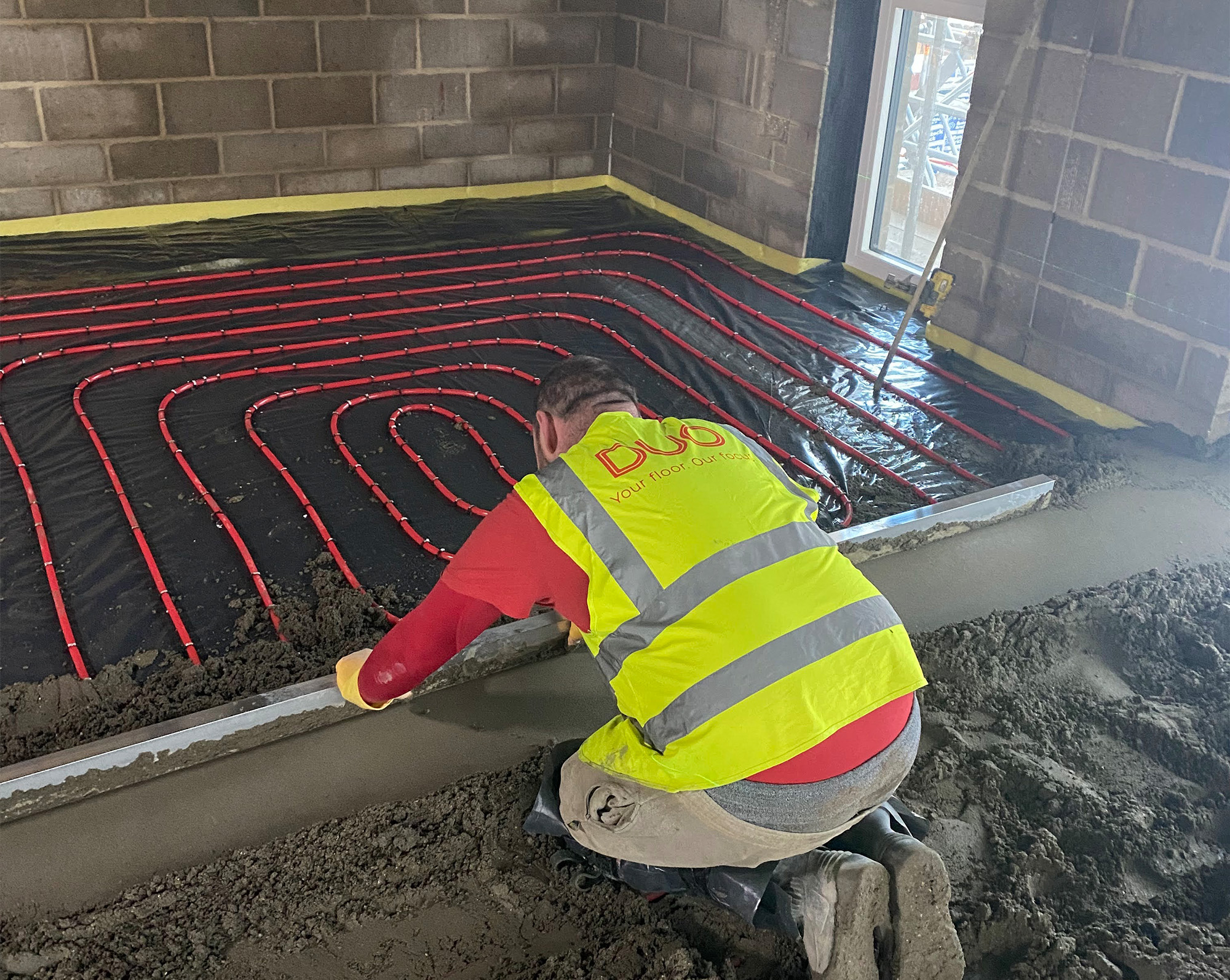You can safely use underfloor heating bedroom carpet in your home, and it can be one of the best ways to enjoy warmth and comfort all year round. Many people assume carpet can block heat, but with the right carpet type and proper fitting, it works perfectly with underfloor heating systems.
This setup is becoming more popular across UK homes because it combines energy efficiency with the cosy feel of soft flooring. When done correctly, underfloor heating beneath carpet can warm your bedroom evenly, avoid cold spots, and even help lower your energy bills.
However, not every carpet is suitable for use with underfloor heating. You need to understand the tog rating, how carpet materials affect heat transfer, and how to pair it with the right underlay. Get these things right, and you’ll have a bedroom that’s warm underfoot from morning to night.
This expert guide will walk you through all the basics of underfloor heating with carpet in bedrooms. We’ll explain which carpets work best, how it feels compared to radiators, what to look out for during fitting, how much it costs, and how to get it done properly without making costly mistakes.
If you’re thinking about upgrading your bedroom or building new, this is the no-nonsense guide to help you decide if underfloor heating with carpet is right for you. By the end, you’ll be confident in what works, what doesn’t, and how to make the right choice for comfort, savings, and peace of mind.
What Type Of Carpet Works Best With Underfloor Heating?
When planning underfloor heating bedroom carpet, choosing the right type of carpet is just as important as the heating system itself. Not all carpets are made equal. Some materials and backings work well with heat, while others trap it and reduce the system’s efficiency. Here’s what you need to know to avoid costly mistakes.
Start with the Tog Rating
The tog rating tells you how much heat a carpet and underlay will keep in. The higher the tog, the more insulation it provides. But with underfloor heating, you don’t want too much insulation.
- The ideal combined tog rating (carpet + underlay) should be 2.5 or below.
- If the tog rating is too high, the heat will struggle to pass through, meaning your room won’t warm up properly.
Choose the Right Carpet Material
The best carpet materials for underfloor heating are those that let heat flow through easily.
- Wool blends and synthetic fibres like nylon or polypropylene are great choices.
- Avoid thick shaggy carpets or deep pile ones. These feel soft, but they act like a barrier and trap heat.
Backing Materials Matter Too
Carpet backings can help or hurt your system.
- Hessian or woven backings are the top choice. They allow heat to pass through and don’t block the flow.
- Foam and rubber backings hold in too much heat and reduce the system’s performance.
Underlay: Don’t Overlook It
Your underlay must also be compatible with underfloor heating.
- Look for underlays designed specifically for heated floors.
- Just like carpet, they must have a low tog rating.
Common Mistakes to Avoid
- Picking a carpet just because it’s soft underfoot
- Using standard underlay without checking its heat resistance
- Choosing thick pile rugs on top of your heated floor
Getting the right carpet for your underfloor heating setup isn’t hard, but it does take a bit of planning. The right choice means your bedroom will be warm, efficient, and safe—all year round.

How Underfloor Heating Bedroom Carpet Improves Comfort And Efficiency
Installing underfloor heating for bedroom carpet is one of the most effective ways to turn a cold, draughty room into a warm and inviting space. Many homeowners are surprised at how much of a difference it makes in both comfort and energy use. If you’re used to radiators, this system will feel like a complete upgrade. Here’s why.
- Say Goodbye to Cold Mornings
One of the best things about underfloor heating with carpet is the comfort it brings when you wake up. No more stepping onto icy floors. Instead, the warmth comes from beneath your feet, evenly spread across the entire room. It doesn’t matter where you walk—the warmth is there waiting.
- Even Heating Throughout the Room
Radiators heat from one spot, usually by the wall. That often leads to hot corners and chilly areas elsewhere. Underfloor heating solves this by pushing warmth from the ground up. This means the whole room is the same temperature—no cold spots, no wasted heat.
- Works Quietly in the Background
Unlike fan heaters or old radiators that click and groan, underfloor heating makes no noise. Once it’s installed and running, you’ll barely notice it’s there—until you realise how warm your feet are.
- More Space and Better Design
Radiators take up wall space and limit how you place furniture. With underfloor heating, everything is hidden below the floor. This gives your bedroom a cleaner look and more layout options. You can move beds, wardrobes, or desks anywhere without worrying about blocking the heat.
- Energy Efficient and Money Saving
Because the system works at a lower temperature and spreads warmth more evenly, it doesn’t need to work as hard as radiators. This means it uses less energy, helping to cut your heating bills. If your home is well-insulated, these savings add up quickly.
- Keeps Air Quality Better
Traditional heating systems rely on pushing warm air around, which can stir up dust. Underfloor heating warms the room without blowing air, helping to reduce allergens—especially helpful if anyone in the house has asthma or allergies.
When you combine underfloor heating with the right carpet, your bedroom becomes warmer, quieter, and more energy-efficient. It’s a clear comfort upgrade that makes every winter night feel like a luxury.
Installation Tips: What You Need Before Laying Carpet Over Underfloor Heating
Fitting underfloor heating bedroom carpet isn’t just about picking the right carpet and switching on the system. To get the best results, you need to prepare properly before installation. Doing it the right way helps your heating system work better, keeps your carpet in good shape, and saves you from costly mistakes.
- Start with a Proper Subfloor Check: Before anything goes down, your installer should check that the subfloor is smooth, clean, and dry. If it’s uneven or has moisture issues, the heat may not spread evenly or safely. A smooth subfloor also prevents damage to the heating elements.
- Use Compatible Materials: It’s important to use carpet, underlay, and adhesives that are specifically made to work with underfloor heating. If any part of the flooring setup has a high tog rating or doesn’t allow heat to pass through, the system will become less efficient. Always ask your supplier if their products are rated for use with underfloor heating.
- Insulation is Key: To make sure heat goes upward into your room (and not downward into the floor), good insulation is a must. Most systems include a layer of thermal insulation before laying the heating mat or pipes. This keeps the warmth inside your home and cuts energy waste.
- Lay the Heating System with Care: If you’re installing electric underfloor heating, the mats or cables need to be spread out evenly across the floor. For water-based systems, the pipes are laid and connected to a heat source. Either way, everything must be tested before the carpet and underlay are added.
- Let the Floor Settle First: Once the system is installed, it needs to stay off for a few days to let all materials settle. Turning the system on too soon can damage the adhesive, flooring, or even the heating elements. Most pros suggest waiting at least 48 to 72 hours before switching it on.
- Get a Professional Installer: While DIY might sound tempting, a certified installer will make sure everything is done safely and meets building regulations. They’ll also test the system before the carpet goes down to make sure it works perfectly.
By taking these steps, you’ll avoid delays, protect your flooring, and enjoy reliable warmth from day one. Proper preparation is the secret to a cosy, energy-efficient underfloor heating system.

Costs And Long-Term Benefits You Should Expect
Before investing in underfloor heating bedroom carpet, it’s important to know what it will cost and what you’ll get back from it in the long run. While the upfront price can feel high, many homeowners find that the comfort, energy savings, and ease of use make it well worth it over time.
How Much Does It Cost?
The cost depends on the type of system you choose (electric or water-based), the size of your room, and the materials used for your carpet and underlay.
- Electric underfloor heating is usually cheaper to install, with prices starting from £300 to £800 for a bedroom. It’s a good choice for single rooms and quicker projects.
- Water-based systems cost more to install, ranging from £1,000 to £2,500+, but they’re more energy-efficient in the long run.
On top of the heating system, factor in the cost of:
- Carpet and underlay suited for underfloor heating (tog rating 2.5 or lower)
- Labour if you hire a professional installer
- Thermostat or smart controls
Running Costs
Underfloor heating is cheaper to run than many people expect. Because it works at a lower temperature and spreads warmth evenly, it doesn’t have to work as hard as traditional radiators. Over time, this can lower your monthly heating bills—especially if your home is well-insulated.
- Electric systems are slightly more expensive to run but ideal for smaller spaces.
- Water systems are more cost-effective for bigger rooms or whole-house setups.
What Do You Save?
Once fitted, underfloor heating needs little to no maintenance. Unlike radiators that might need bleeding or replacement valves, underfloor heating just works—quietly and effectively. That means fewer repair bills and no stress about uneven heating.
Plus, having underfloor heating can boost your home’s value. Many buyers now look for energy-efficient upgrades, and heated floors are considered a luxury feature, especially in bedrooms.
The Comfort Is Worth It
Even if the savings took time to show, many homeowners say the comfort alone is enough. Stepping onto a warm floor in the morning, having no cold spots, and knowing your home is using energy wisely—it all adds up to a better living experience.
In short, the cost of installing underfloor heating is balanced by long-term savings, added home value, and daily comfort.
It’s Time To Upgrade Your Bedroom Comfort
If you’re thinking about whether underfloor heating bedroom carpet is worth the investment, the answer is simple — yes, it is. From the moment you step out of bed onto a warm, soft floor, you’ll understand why so many homeowners are making the switch. It’s not just about luxury. It’s about warmth, energy savings, and comfort you can feel every day.
When done right, underfloor heating works perfectly with carpet. You just need to make sure the carpet and underlay are compatible, keep the combined tog rating below 2.5, and have everything installed properly. Once that’s sorted, you’ve got a system that runs quietly, warms the entire room evenly, and helps keep your energy bills lower over time.
I always tell homeowners this — if your bedroom is the one place you want to feel peaceful, soft, and warm, then underfloor heating with carpet is the best solution. It adds real value to your home and makes a difference from day one.
At Duo Systems, we know how to make this upgrade as smooth and stress-free as possible. From helping you choose the right carpet to fitting the entire system properly, we’ve got the knowledge and the experience. We’ll give you advice that makes sense, pricing that’s clear, and installation that’s done to the highest standard.
Call us today on 02380 675 888 to get a free consultation or to book your expert fitting. Let’s help you make your bedroom the warmest and most comfortable room in your home, just the way it should be.


